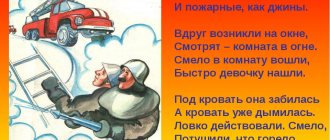Lesson notes on the painting “Bird Yard” in the middle group
Tatiana Golonkova
Lesson notes on the painting “Bird Yard” in the middle group
Subject. Story based on the painting " Poultry Yard "
.
Educational goals: Learning to write a story based on a picture .
Developmental goals: Development of coherent speech, clarification of vocabulary on the topic “Poultry”
, formation of natural science concepts, development of thinking, visual attention, creative imagination.
Educational goals: developing a caring attitude towards pets.
Preliminary work: listening to the Russian folk tale “Ryaba Hen”
, the story by K. Ushinsky
“Cockerel with his family”
, the fairy tale by V. Suteev
“Chicken and Duckling”
, the story by E. Charushin
“Ducks”
, memorizing quatrains from the coloring book
“Poultry”
.
A fairy tale without a happy ending
The fairy tale about the chicken and the broken egg was published by Afanasyev in two versions. The first, recorded in the Bobrovsky district of the Voronezh province, was like this: “Once upon a time there lived an old man with an old woman, they had a Tatar hen, she laid an egg in the kut under the window: motley, colorful, boney, tricky! I put it on the shelf; The mouse walked, shook its tail, the shelf fell, and the egg broke. The old man is crying, the old woman is sobbing, the stove is on fire, the top of the hut is shaking, the girl-granddaughter hanged herself out of grief. Mallow comes and asks: Why are they crying so much? The old men began to retell the story... As soon as Mallow heard, she broke all the Mallows and threw them away. The sexton comes up and asks the breadmaker: why did she throw away the bread? She told him all the grief; the sexton ran to the bell tower and broke all the bells. The priest comes and asks the sexton: why did you break the bells? The sexton recounted all the grief to the priest, and the priest ran and tore up all the books.”
The second version, recorded in the Arkhangelsk province, was not so tragic: the granddaughter did not kill herself, the bells in the church remained intact, and the priest tore not the books, which suggested a monstrous sacrilege, but the book (in the singular). This made it possible to think that his vandalism was limited to the parish register, that is, the records of the village registry office of that time, which, however, also created a serious problem for the village residents (it would be problematic to restore who was born, baptized, married, and died when). True, the old people's yard suffered more in this version: in addition to the shaky ceiling in the hut, the doors in it began to sag (crooked), the rubbish under the threshold began to smoke (that is, the entire hut was shaking from the stream to the floor), in the yard the gates began to creak, and the ropes (pillars) , on which the gates are hung) - to laugh, the tyn crumbled. In other words, the fence fell, only the stronger gate stood.
Subsequently, folklorists published about 20 more Russian, Ukrainian, Balkan and Baltic versions of the tale. In the most brutal of them, in addition to the granddaughter who hanged herself, a priest also dies, who tore all the books and burned the church, and he himself “killed himself on a corner.” In the mildest cases, everyone remains alive, but the shock of people from the news of a testicle broken by a mouse was great - both figuratively and literally. The hut of my grandfather and grandmother, the owners of the hen Ryaba, is being hit by something like a hurricane measuring 9 on the 12-point Beaufort scale and an accompanying earthquake measuring 6-7 on the 12-point MSK scale. But the main thing, of course, is not the destruction in the old people’s house and in their yard - even a child listening to the fairy tale could understand that this was a fixable matter, but the fact that in all folk versions without exception, this fairy tale cannot be called uplifting; on the contrary, everything ends badly there and there is no hope for the best.
Finnish taxonomy
As mentioned above, the plot of this tale is found among many nations, and sometimes it is so disguised by national characteristics that special research is required to get to the essence of the tale and correctly classify it according to the plot. At the same time, the matter is complicated by the fact that there are now several main classifications of fairy tale plots and it is necessary to turn to comparative indexes of plots, of which there are also several, and they also differ from each other. In a word, the situation in fairy-tale folklore now is the same as it was in biology before Linnaeus’ “System of Nature” or in chemistry before Mendeleev’s Periodic Table of Elements.
For example, in the “Index of fairy-tale plots according to the Aarne system” by N.P. Andreev, plot 241 III (2022) “The hen laid a golden egg: the mouse broke it, the old woman was crying, the old man was crying behind her, the sexton was behind him, etc., etc. d." is found in Section I, “Tales of Animals” (plots 1–299), subsection “Birds and Fishes” (plots 220–274). And, for example, in the latest edition of Stith Thompson’s Motif-index of folk-literature, this plot numbered B103.2.1 (Bird lays money or golden eggs or an egg) is in the group B100-B119. Treasure animals ("Treasures of animals") subsections B100-B199. Magic animals (“Magical animals”) section B. Animals (“Animals”). And these are just two “determinants” of fairy tale plots - ours and the American one.
With such national “pluralism” in taxonomy, biology, for example, simply would not exist as a science. Carl Linnaeus in the 17th century brought order to it and put everything into shelves, where even a schoolchild could easily find what he needed; in chemistry, Dmitry Mendeleev did the same in the 19th century. The first to try to restore order in folklore was Antti Aarne, a professor at the Imperial Alexander University (now the University of Helsinki). His first “Index of Fairy Tale Types” was published in German in 1910, then it was reprinted several times, supplemented and continues to be supplemented and corrected to this day in the form of the “Index of Folk Tale Plots” (ATU Index - Aarne-Thomson-Uther Index). But such comparative indexes are quite difficult to use even for specialists.
The reason for this discrepancy was pointed out by Leningrad University professor Vladimir Propp back in the 1920s: “While the physical and mathematical sciences have a coherent classification, a uniform terminology adopted by special congresses, a methodology that was improved by continuity from teachers to students, we have all this no... It is also completely obvious and does not require any proof that the origin of any phenomenon can be discussed only after the phenomenon has been described. Meanwhile, the study of the fairy tale was carried out mainly only genetically, for the most part without attempts at a preliminary systematic description... It is clear that before illuminating the question of where the fairy tale comes from, it is necessary to answer the question of what it is... Although classification forms the basis of any study, itself it must be the result of a certain preliminary elaboration. Meanwhile, we see just the opposite: most researchers begin with classification, introducing it into the material from the outside, and not deducing it from the material essentially... Classifiers, moreover, often violate the simplest rules of division. Here we find one of the reasons for the deadlock...”
In short, Professor Propp reproached his colleagues for missing a whole stage in the evolution of any science - the descriptive one; they stubbornly do not admit it and continue to put things that they themselves do not fully understand, or at least have not fully researched, into the shelves they have invented. Professor Propp spoke bitter words, but he had the right to do so: in the 1920s, especially in the second half, fairy tale folkloristics flourished in our country. Within the framework of the State (formerly Imperial) Russian Geographical Society, the “Fairytale Commission”, chaired by Academician Oldenburg, resumed its work.
Just think: in 1929, the year of the “Great Turning Point” according to Stalin’s definition, when the gallant march of aviators “We were born to make a fairy tale come true” sounded throughout the country, Soviet folklorists and storytellers held a symposium discussing the Verzeichnis der Mrchentypen of the “White Finn” Aarne . The upper echelon of Soviet power at all times treated fairy tales favorably and created no less comfortable working conditions for fairy tale scientists than for scientists working for defense. Suffice it to say that the complete academic edition of fairy tales was blessed by the Chairman of the Council of People's Commissars (government) Vyacheslav Molotov.






